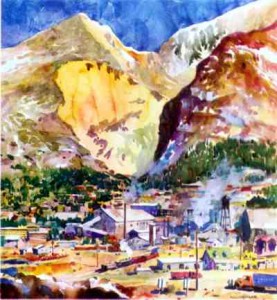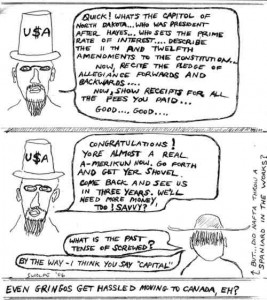Review by Ken Wright
Pre-Columbian America – June 2006 – Colorado Central Magazine
1491: New Revelations of the Americas before Columbus
by Charles C. Mann
published in 2005 by Alfred A. Knopf
ISBN 1-4000-4006-X
THE TRUTH CHANGES THINGS. And some of those things are hard to change.
Take, for example, our vision of what the “New World” was like before the “Old World” stumbled across it in 1492.
That vision, to make a broad generalization, is this: before Columbus’s ominous arrival, the New World was a lightly populated land inhabited by peaceful people living in Garden-of-Eden-like harmony with a big, unbroken wilderness. These people had been living primitive hunter-gatherer lives since they crossed the Bering Land Bridge some 10,000 years ago. This world persisted unbroken until after 1492, when native peoples were decimated by the overwhelming technology of the Old World invaders. After that, the archaic and virgin wilderness of the New World was tamed and domesticated.
If that sounds familiar, then pretty much everything you thought is wrong.
At least that’s what the past three decades of archæological research suggests. Breakthroughs and discoveries in exploring the history of the Americas before 1492 argue that much of the New World was inhabited — and on its way to being highly civilized — long before Europe was freed from the grip of Ice Age ice sheets, and some of the greatest developments in civilization actually were already under way in the Americas when or before similar experiments were begun in Sumer and Mesopotamia.
Charles C. Mann, a journalist for Atlantic Monthly and Science, compiles these new and mind-altering discoveries into a compelling and engaging narrative in 1491: New Revelations of the Americas Before Columbus. This recent research, which has yet to reach our textbooks or filter into popular culture, has shed new light into what Mann calls “one of the biggest blanks in history: the Western Hemisphere before 1492.”
“In almost every case,” argues Mann, “Indian societies have been revealed to be older, grander, and more complex than was thought possible even twenty years ago.” In particular, records show that when Europeans first arrived, Indian weapons and their skill with these weapons were in every way superior to the European arms. The two cultures “faced each other as relative equals,” says Mann.
So, what happened? In a word, disease. Delivered unwittingly by the earliest of the European visitors, these diseases tore through a people defenseless against the microbes, ultimately killing 90 percent or more of the native population before most European visitors even arrived. This disaster, and later European imperialism that ruined native records, effectively erased all memory of the cultures and histories that existed before contact. They didn’t know it, but Europeans had set up shop in a world recently shattered and suffering major shifts in the regional power balances, as well as heart-rending existential malaise.
“So thorough was the erasure,” Mann explains, “that within a few generations neither conqueror or conquered knew that this world had existed.”
“The disintegration of native America was a loss not just to those societies but to the human enterprise as a whole,” he adds. “Having grown separately for millennia, the Americas were a boundless sea of novel ideas, dreams, stories, philosophies, religions, moralities, discoveries, and all the other products of the mind.”
BUT PERHAPS THE MOST INTERESTING FACET of this new-found and valuable history may have to do with the nature of Nature before Columbus.
New research has uncovered this mind-boggling figure: At the time of Columbus’s arrival, as much as two-thirds of what is now the continental United States was agricultural. All across the Americas, both north and south, vast and deliberate terra-forming, engineering, and selective shaping of ecosystems had created a thoroughly human-crafted environment — what Mann calls “the world’s largest gardens.”
Perhaps the biggest lesson here is that Native American agriculture featured some key differences from Eurasian-style “domestication” and industrial agriculture. This Native American form of agriculture seems to have been for … well, food. But rather than food for commerce, for business, for global multinational stockholder portfolio maximization, Indian agriculture seems to have been designed for sustainability and public access — nurturing public nature.
Particular achievements Mann cites in Indian agriculture include the Milpa — sustainable farming by mixing crops that are both nutritionally and environmentally complementary, thereby improving rather than weakening the soil. One scientist calls it “one of the most successful human inventions ever created.”
Mann also argues that Indian people practiced large-scale landscape management: Terracing, selective harvesting, animal control, and fire-management. In particular, Indian peoples seem to have shaped the forests of North America into virtual orchards, and to have reshaped habitats to favor certain animals. But “rather than domesticate animals for meat,” says Mann, “Indians retooled ecosystems to encourage elk, deer, and bear,” where hunting parties could venture from the cities and village.
Perhaps most amazing of all, though, are recent discoveries that suggest the great Amazon forest is a cultural artifact — having been molded over millennia into de facto orchards. One ecologist quoted in the book claims, “The lowland tropical forests of South America are among the finest works of art on the planet.”
The result of these impressive developments in sustainable agriculture, says Mann, was that “at the time of Columbus the Western Hemisphere had been thoroughly painted with the human brush.” But when Indians were displaced and disenfranchised, the effects on the landscape rippled. “When Indian societies disintegrated from disease and mistreatment,” says Mann, “forest invaded savanna in Wisconsin, Illinois, Kansas, Nebraska, Wyoming, and the Texas hill country. Europeans forgot what the landscape had looked like before and why.” And where Europeans marveled at prodigious herds of buffalo and flocks of passenger pigeons large enough to darken the skies for days, they were really seeing previously managed populations suddenly run amok.
These, and other ideas revealed in 1491, are somewhat shocking, and are sure to shake our images of ourselves and the world we live in.
For example, what is our obligation to America’s native peoples in the face of these new revelations? Mann says that the carriers of the disease that decimated the unprepared peoples in the Americas were “responsible, but not guilty.” But, he adds, “guilt is not readily passed down the generations, but responsibility can be.”
“A first step toward satisfying that responsibility for Europeans and their descendants in North and South America,” Mann argues, “would be to treat indigenous people today with respect — something that, alas, cannot yet be taken for granted. Recognizing and obeying past treaties wouldn’t be a bad idea, either.”
Another question, though, is one that Mann does not address: Where should the environmental and wilderness preservation movements stand in the face of this new picture of pre-Columbian America?
The answer seems to be that we can no longer argue that “wilderness” means that we should leave the land alone and see how it goes. But that doesn’t mean that anything goes when messing with ecology, either. Instead this new outlook on history implies that wilderness defenders should stand up for wildlands because they are something “we want.”
This new view about how Indian peoples lived tends to alter our much-treasured definition of “wilderness.” But that doesn’t mean the loss of wilderness. On the contrary, reading 1491 gives one a fresh perspective on wildlands, and opens up a whole new world of possibilities, choices, responsibilities, and ideas.


